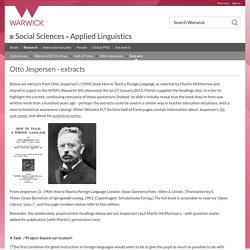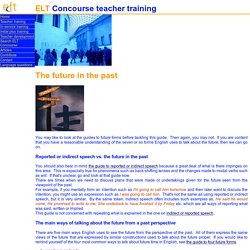

Binbd8112af 7968 429f aafd c6c3870e6603. Otto Jespersen - extracts. Below are extracts from Otto Jespersen's (1904) book How to Teach a Foreign Language, as selected by Martin McMorrow and shared in a post to the IATEFL Research SIG discussion list on 27 January 2015.

Martin supplied the headings also, in order to highlight the current, continuing relevance of these quotations (indeed, he didn't initially reveal that the book they're from was written more than a hundred years ago - perhaps the extracts could be used in a similar way in teacher education situations, with a view to historical awareness-raising). Other Warwick ELT Archive Hall of Fame pages contain information about Jespersen's life and career, and about his published works.
From Jespersen, O. 1904. How to Teach a Foreign Language. London: Swan Sonnenschein / Allen & Unwin. Reminder: the deliberately anachronistic headings below are not Jespersen's but Martin McMorrow's - with question marks added for publication (with Martin's permission) here. A Task- / Project-based curriculum? Key Concepts in ELT. Useful links for CELTA.
Anyone following my blog will know that CELTA took over my life in August last year (2014), and will continue to dominate until the same time this year (2015). I’ve been building this list in my head for a while, and it’s finally time to get it onto the blog. It’s arranged into categories, with subtitles and topics in bold to help you navigate. There’s a lot here, so just use the bits you need as you need them rather than trying to look at all of them – if not, you’ll end up being overwhelmed! A quick way to find what you need it to press CTRL + F (CMD + F on a Mac) and type a key word connected to what you’re struggling with, like ‘TTT’, ‘instructions’ or ‘writing’ – this will take you straight to the relevant section.
Please let me know if any of the links are broken so I can update them, and feel free to add suggestions to the comments. Before the course. Teach with Confidence: Nervousness is Energy in Disguise! – tekhnologic. Do you teach with confidence or do you feel nervous before a lesson begins?

More importantly, how do you overcome feeling nervous? I’m afraid I don’t have the answer to that question, the answer to that question is different for everyone. When I started teaching, I didn’t like talking in front of people. I felt nervous, my heart would race and I would get the shakes. I sometimes even wondered if teaching was for me and if I was making a mistake. Then one day I happened to see a video about presentation techniques and public speaking skills. I think it has changed me. I remind myself that nervousness is energy in disguise and I whenever I feel nervous I don’t think of it as a bad thing, I try turn it into a positive experience and channel that energy into a performance.
So, I have suggested 12 tips and brought together a selection of TED talks and resources, so that you can decide for yourself what it takes to teach with confidence. Contents #1 Plan Your Lessons Top. Celta pyramid. ELT Concourse guide to the future in the past. You may like to look at the guides to future forms before tackling this guide.

Then again, you may not. If you are content that you have a reasonable understanding of the seven or so forms English uses to talk about the future, then we can go on. Reported or indirect speech vs. the future in the past You should also bear in mind the guide to reported or indirect speech because a great deal of what is there impinges on this area. This is especially true for phenomena such as back-shifting tenses and the changes made to modal verbs such as will. The main ways of talking about the future from a past perspective There are five main ways English uses to see the future from the perspective of the past.
Was/were going to This is sometimes called the unfulfilled intention construction. None of the above (with the exception of the rarer would form) are particularly difficult to understand (or learn) but time lines always help: A short test on this. The Australian news. †Introductory offers to be billed 4 weekly as per the following - The Australian Digital Subscription $3 per week, $12 billed 4 weekly; The Australian Digital Subscription + weekend paper delivery $3 per week, $12 billed 4 weekly; The Australian Digital Subscription + 6 day paper delivery $6 per week, $24 billed 4 weekly.

At the end of the initial 12 weeks, subscriptions will automatically renew to the higher price to be billed 4 weekly as per the following - The Australian Digital Subscription $6 per week, $24 billed 4 weekly; The Australian Digital Subscription + weekend paper delivery $6 per week, $24 billed 4 weekly; The Australian Digital Subscription + 6 day paper delivery $12 per week, $48 billed 4 weekly, unless cancelled. Payments in advance by credit/debit card or Paypal only. Offer is only available where normal home delivery exists and not where additional freight is ordinarily charged. Full offer terms and conditions apply - see www.theaustralian.com.au for full details.